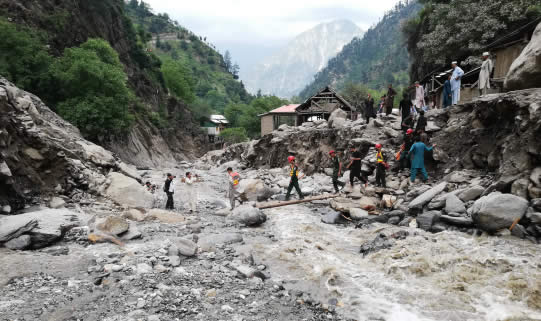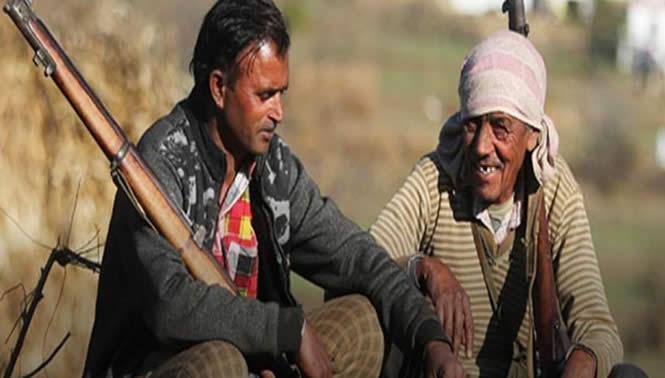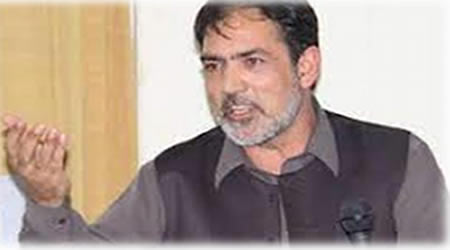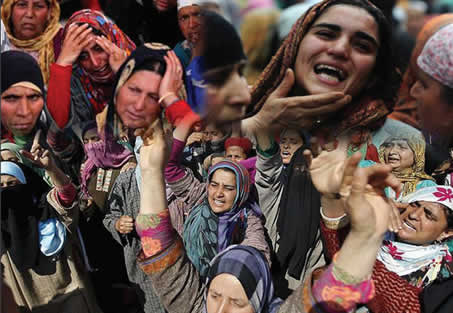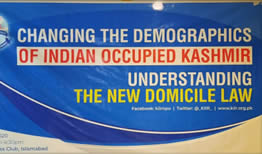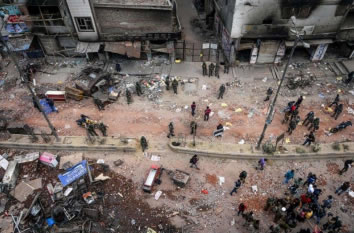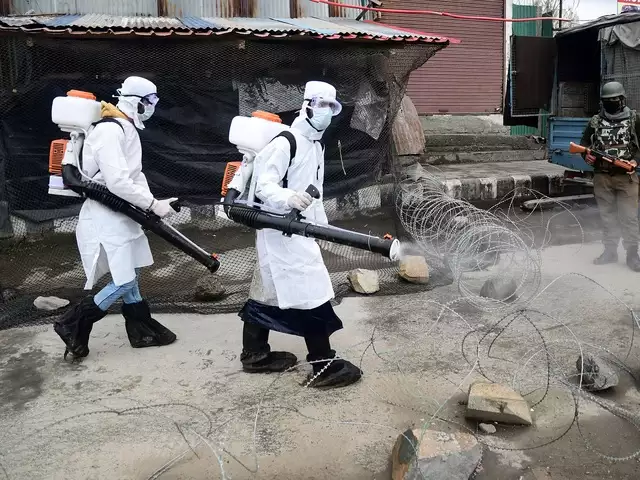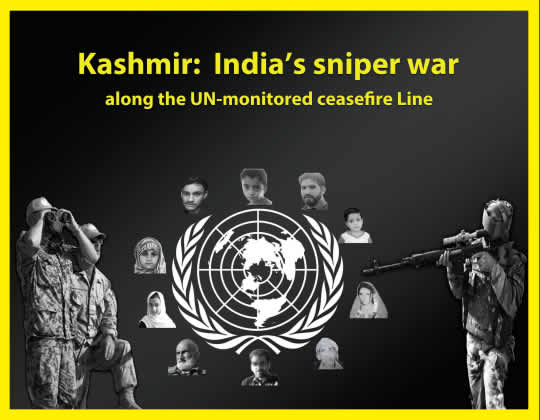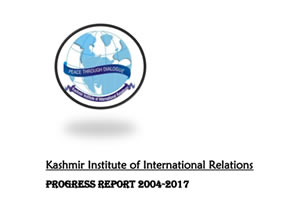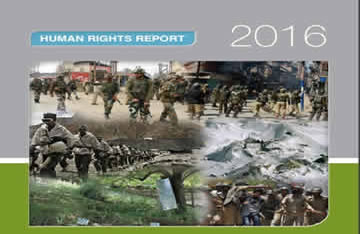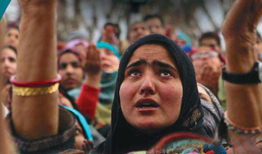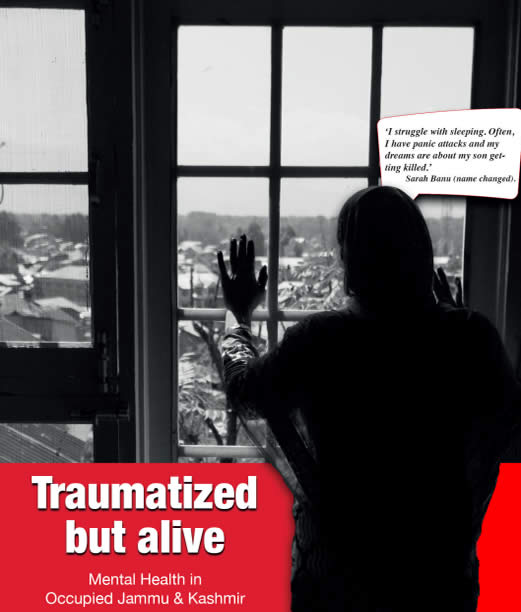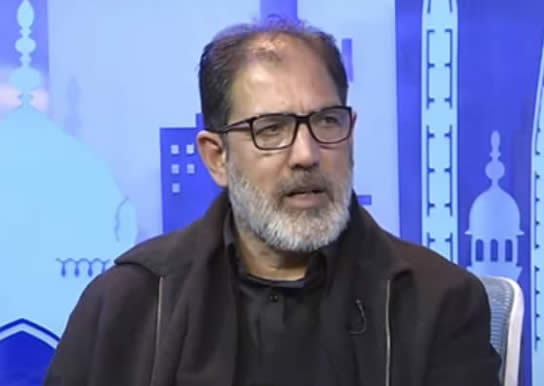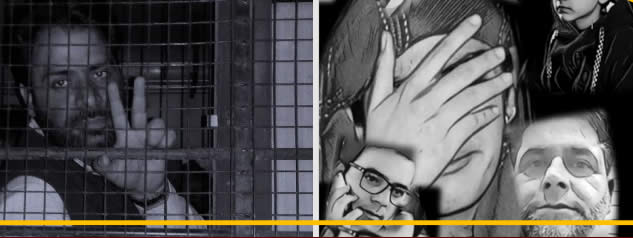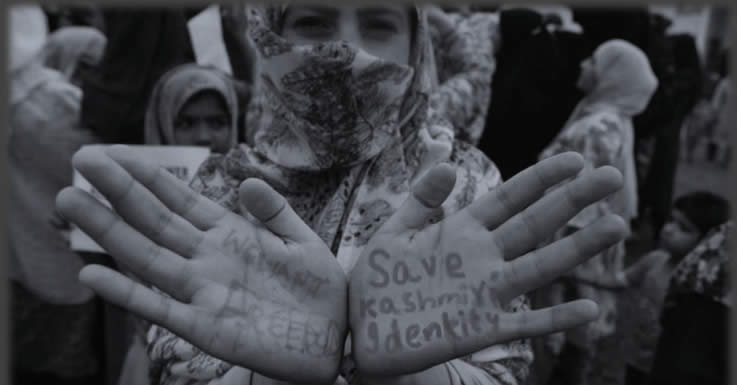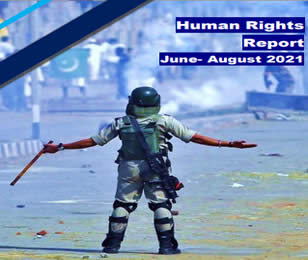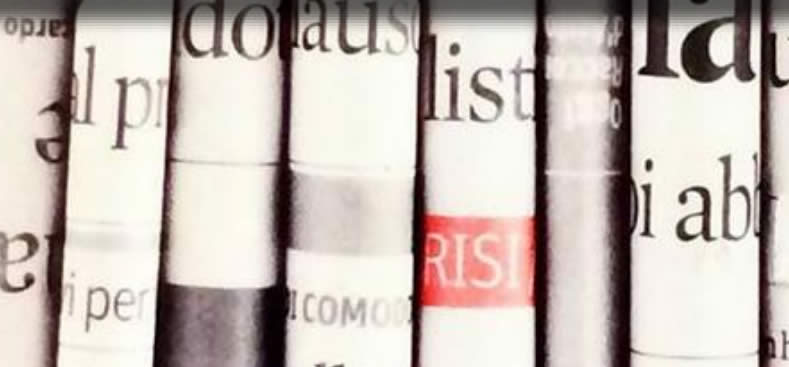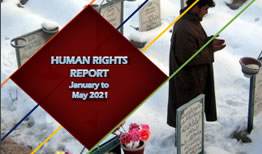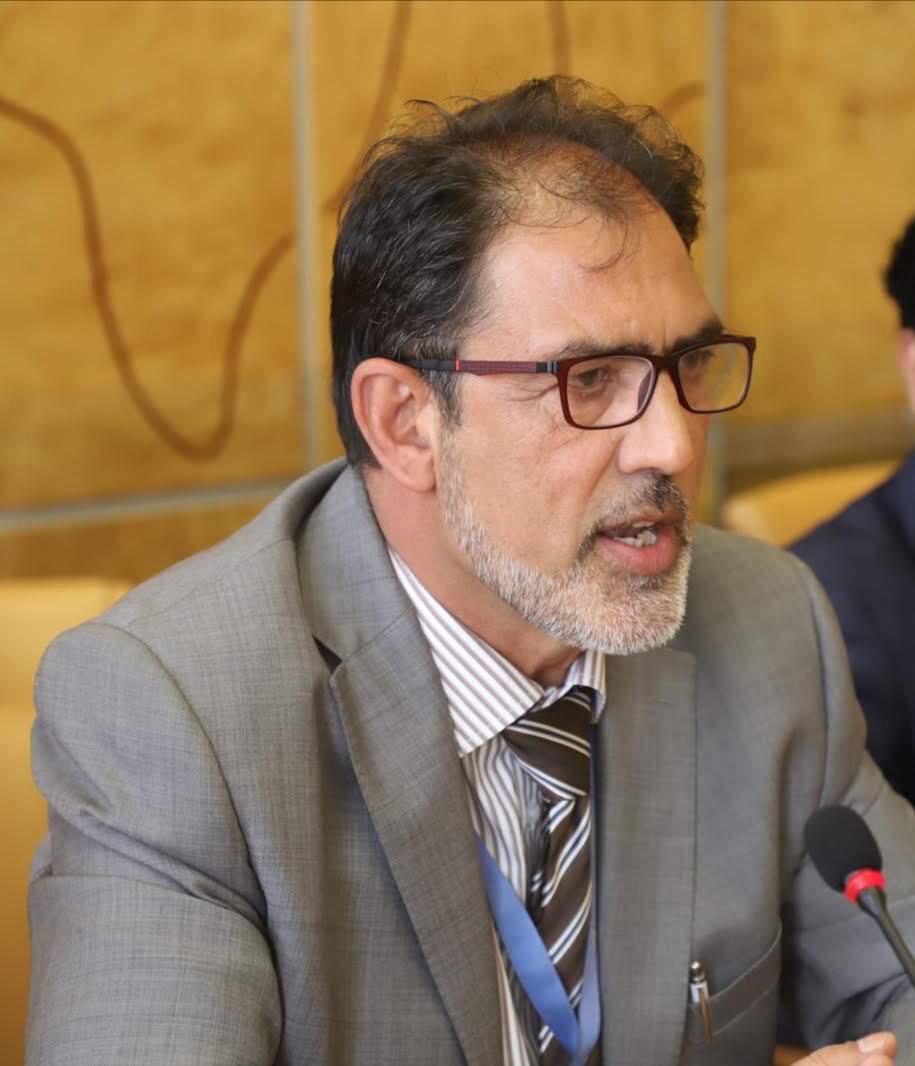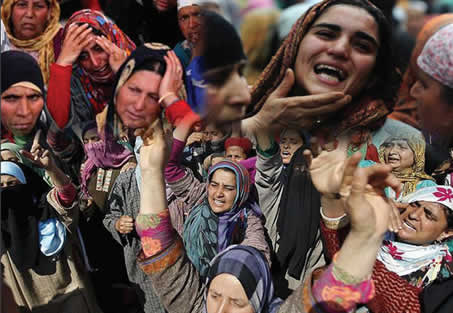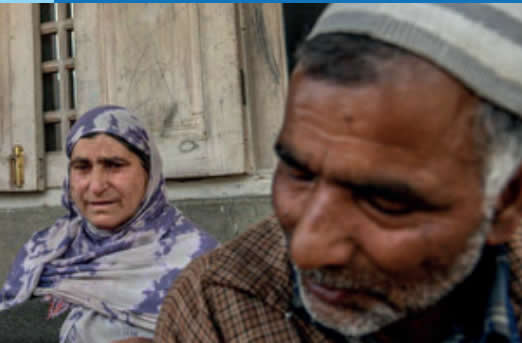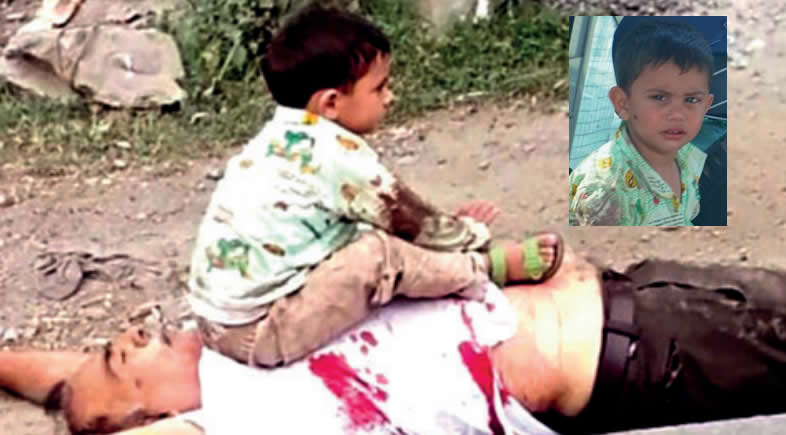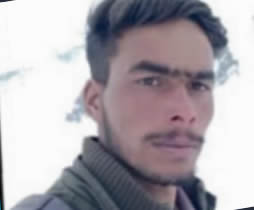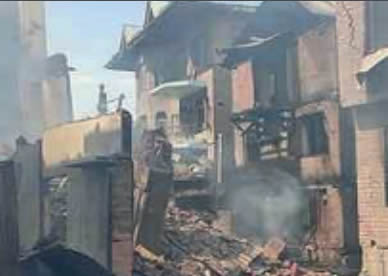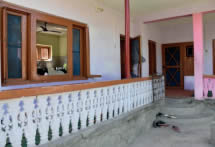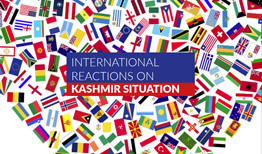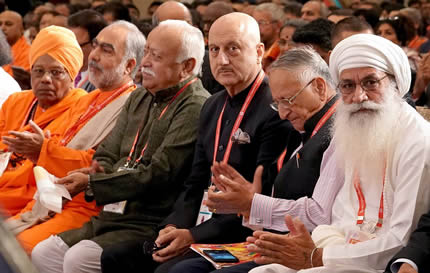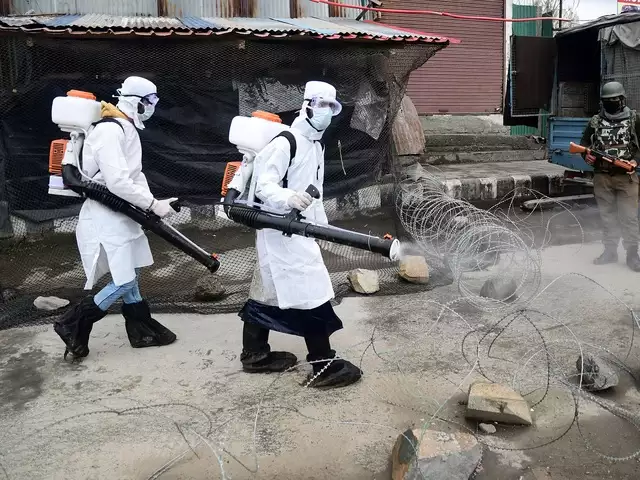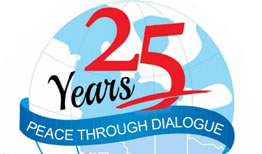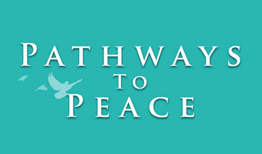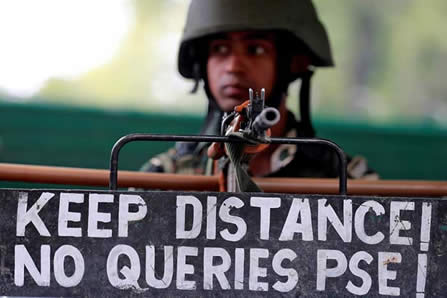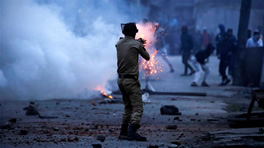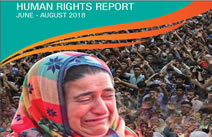HUMAN RIGHTS REPORT
HUMAN RIGHTS REPORT
EROSION OF AUTONOMY AND RIGHTS FROM AUGUST 5, 2019, TO AUGUST 5, 2025
Since the unilateral abrogation of Article 370 in August 2019, India has systematically attempted to dismantle Kashmir’s distinct political, legal and cultural identity. On July 27, 2025, Delhi-appointed Lieutenant Governor Manoj Sinha admitted that more than 800 Indian laws have been extended to Indian illegally occupied Jammu and Kashmir (IIOJK) (KMS, 2025). While the administration claims these laws promote “justice and equality,” human rights observers argue they serve as tools of forced assimilation and demographic manipulation. Experts highlight that many of these laws bypass local governance and erase centuries-old customary rights, facilitating the colonization of the territory.
India’s approach to “security” in IIOJK has been marked by extreme militarization, often justified under the pretext of protecting Hindu pilgrims. During the 2025 Amarnath Yatra, over 8,500 Indian army personnel were deployed, supported by thousands of paramilitary troops, specialized engineer teams, drones and signal jammers (India TV News, 2025). These troops operated alongside Central Armed Police Forces (CAPFs), bomb disposal squads and K9 units, forming a high-tech security grid to manage pilgrim movement. Earlier, in June 2025, an additional 580 CAPF companies were mobilized across the territory, including 400 concentrated along the Pahalgam and Baltal routes (KMS, 2025).
DENIAL OF RELIGIOUS AND CULTURAL RIGHTS
While the Indian state expends massive resources on Hindu pilgrims, it simultaneously denies basic religious freedoms to Kashmiri Muslims. Since August 2019, Srinagar’s historic Jamia Masjid and Eidgah grounds have remained closed during major religious events, including Eid congregations (KMS, 2025). Muharram processions are also regularly prohibited, reflecting systematic restrictions on religious and cultural expression.
DEMOGRAPHIC ENGINEERING IN LADAKH
India’s new domicile, reservation and language policies in Ladakh, implemented in June 2025, reveal another layer of strategic colonization (KMS, 2025). Residents with 15 years of continuous stay since 2019 now qualify as domiciles, allowing non-native populations to claim local status by 2034. Additionally, children of government officials serving ten years and students studying locally for seven years, are also granted domicile status. The government introduced 85% reservation for Scheduled Tribes in government jobs, even though more than 97% of Ladakh’s population already belongs to ST communities.
Simultaneously, one-third of seats in autonomous hill councils are reserved for women and multiple languages, including English, Hindi, Urdu, Bhoti and Purgi, are officially recognized, with limited institutional support for native languages like Shina, Balti, Brokskat and Ladakhi. While framed as inclusive reforms, critics argue these policies reshape the demographic and linguistic character of Ladakh, reflecting a colonial strategy aimed at long-term assimilation (The Times of India, 2025).
SUPPRESSION OF DISSENT AND POLITICAL FREEDOM
The period from 2019 to 2025 has witnessed unprecedented political suppression in IIOJK. India has intensified surveillance, imposed curfews and conducted cordon-and-search operations that restrict the population’s movement. Special Forces and paramilitary deployments often coincide with local protests,
suggesting a targeted campaign to quell political opposition. Political leaders and human rights defenders consistently report that the imposition of Indian laws, combined with militarization, leaves residents vulnerable to arbitrary arrests, intimidation and harassment. These practices violate fundamental rights under international human rights law and exacerbate the ongoing crisis, fueling resentment and alienation among Kashmiris (Amnesty International, 2023).
ECONOMIC AND SOCIAL IMPACT
Since the abrogation of Article 370 on August 5, 2019, the people of IIOJK have faced severe economic hardships. The removal of the region’s special status disrupted traditional economic systems and worsened unemployment and poverty. Tourism, which once contributed around 7% of the local economy, has sharply declined due to heavy militarization, security operations and targeted attacks such as the Pahalgam incident in 2025 (AP News, 2025). This has caused widespread loss of income for hotel operators, guides, transport workers and handicraft vendors. Traditional handicrafts and small businesses have also suffered. Frequent lockdowns, restricted movement and excessive regulation have made it difficult for shopkeepers and artisans to maintain their livelihoods (Greater Kashmir, 2025).
Agriculture, especially horticulture, has been hit by unstable markets and government interventions that distort prices, forcing farmers to sell their produce at a loss (KIIR, 2025). Rising inflation and the cost of basic goods have added further pressure on families. Youth unemployment remains high, as few opportunities exist in traditional sectors or government jobs, forcing many to seek informal labor or migrate elsewhere (JKPI, 2025).The cumulative effect of militarization, political instability and systemic marginalization has left Kashmiris economically vulnerable. Without targeted economic reforms, protection of livelihoods and political stability, the people of IIOJK continue to face a bleak economic future, with limited opportunities for recovery or sustainable growth.
MANUFACTURED CRISES: HOW INDIA’S REC KLESSNESS FUELS WAR IN SOUTH ASIA
The Pahalgam attack of June 2025 has become a glaring example of India’s self-inflicted security disaster, with former RAW chief A.S. Dulat himself admitting that the incident was a “total failure” of intelligence and policing (Kashmir Media Service, 2025). Rather than conducting a credible investigation, New Delhi
repeated its old playbook—immediately blaming Pakistan without evidence. This knee-jerk scapegoating reflects a broader pattern in India’s strategy, where propaganda replaces accountability and domestic failures are externalized.
A similar pattern was seen in the Pulwama attack of 2019, where unexplained lapses, suspiciously relaxed security protocols, and unverified claims were used to justify cross-border aggression (The Wire, 2019). Both incidents reveal not Pakistan’s involvement, but India’s reliance on manufactured crises to sustain Hindutva-driven militarized nationalism. The consequences of such recklessness are grave.
By rushing to frame Pakistan, Indian leadership generates war hysteria that emboldens military adventurism. In 2019, this resulted in the Balakot strikes and an aerial dogfight that exposed India’s vulnerabilities when Pakistan downed several Indian aircraft
(Al Jazeera, 2019). In 2025, the same propaganda cycle after Pahalgam escalated tensions, laying the groundwork for Operation Sindoor, a reckless maneuver that brought the subcontinent perilously close to open conflict.
Instead of learning from Pulwama’s blowback, India doubled down on a failed formula of false flag narratives and miscalculated responses. This approach is not only dishonest but destabilizing for all of South Asia. By weaponizing lies, ignoring its own intelligence shortcomings, and militarizing public opinion, India deliberately manufactures crises that edge the region toward war. The Pahalgam fiasco proves once again that New Delhi’s pursuit of political optics over truth and accountability is a dangerous gamble with peace and stability, one that risks catastrophic consequences far beyond Kashmir.
INTERNATIONAL LEGAL PERSPECTIVE
Observers and legal experts argue that India’s actions violate UN Security Council resolutions and international law governing disputed territories (BBC News, 2023). The unilateral imposition of laws, massive militarization, suppression of cultural freedoms and demographic restructuring collectively amount to
colonial-style annexation. International attention has been limited, but human rights organizations continue to monitor developments, highlighting India’s ongoing human rights violations and calling for adherence to the right to self-determination.
his report draws on secondary sources, including verified news reports, official statements, human rights documentation and legal texts. Data was gathered from regional and national media outlets, civil society reportsand publicly accessible databases between June and Aug 2025. All incidents were cross-referenced for consistency and credibility. The analysis draws on international human rights law, critical security studies and decolonial theory to interpret the findings. The methodology prioritizes accuracy, transparency and a grounded interpretive framework suitable for political and legal analysis of state violence in conflict zones.
EXTRAJUDICIAL KILLINGS & CUSTODIAL DEATHS
Since the unilateral abrogation of Articles 370 and 35A on August 5, 2019, IIOJK has experienced a dramatic escalation in human rights violations, with extrajudicial killings and custodial deaths reaching alarming levels. The Indian occupation forces have systematically used lethal force and inhuman detention practices to suppress dissent, creating an environment of fear and intimidation. According to reports, over 1,030 Kashmiris have been killed in encounters orchestrated by Indian forces between 2019 and 2025, highlighting a clear pattern of state-sponsored violence (KMS, 2025). These killings are often framed as legitimate counter-terror operations, yet evidence points to deliberate targeting of political activists, youth and civilians perceived as opposing the Indian occupation.
EXTRAJUDICIAL KILLINGS: A DELIBERATE STRATEGY
Extrajudicial killings have become a core element of India’s strategy to maintain control over IIOJK. Young Kashmiris are frequently killed in staged encounters or during cordon-and-search operations (CASOs), often without credible evidence or due process. For instance, in June 2025, Manzoor Ahmad died under torture while in custody in Islamabad district, despite being an under-trial prisoner. Reports indicate he was tortured for three consecutive days and denied timely medical care, resulting in his death (HRW, 2025). Similarly, in August 2025, Riyaz Ahmed was killed at a Srinagar police station under circumstances suggesting severe custodial abuse, provoking widespread protests across the Valley (Al Jazeera, 2025). These incidents demonstrate that the killings are not isolated but part of a deliberate policy to intimidate the population and crush political resistance.
Between 2019 and 2025, India has escalated its militarized operations in IIOJK, resulting in over a thousand killings, including women, youth and elderly civilians, many of whom were unarmed (Amnesty International, 2024). The targeting of youth, who often constitute the backbone of Kashmiri civil resistance, reflects a calculated approach to suppress dissent. Such extrajudicial killings violate international law, including the ICCPR, which guarantees the right to life and due process. The repeated use of lethal force without judicial oversight undermines the rule of law and reinforces a climate of impunity within Indian-administered Kashmir.
CUSTODIAL DEATHS AND TORTURE
Equally concerning is the widespread practice of custodial abuse, which has led to numerous deaths. Indian authorities routinely detain individuals under draconian laws such as the Public Safety Act (PSA) and the Unlawful Activities (Prevention) Act (UAPA), often without trial or formal charges. In July 2025, legal proceedings in IIOJK demonstrated the judiciary’s complicity in prolonging detention and criminalizing dissent, with two men being sentenced to life imprisonment in decades-old cases despite voluntary surrender and dependent family members (Human Rights Watch, 2025).
Custodial torture has also led to immediate fatalities. In addition to Manzoor Ahmad and Riyaz Ahmed, multiple reports from 2025 indicate that detainees were subjected to physical and psychological torture, including beatings, asphyxiation and denial of medical care (Redress, 2025). Such deaths are often reported as natural or incidental, concealing the culpability of the Indian occupation forces. Data from 2019–2025 suggest that hundreds of under-trial prisoners and detainees have died due to custodial torture in IIOJK, underscoring the severity and systemic nature of the abuse (OMCT, 2025). These practices are in direct violation of the UN Convention Against Torture, to which India is a signatory and constitute clear breaches of international humanitarian law.
The persistence of extrajudicial killings and custodial deaths in IIOJK is not a series of unfortunate incidents but a calculated policy by the Indian occupation forces to suppress political dissent. The large-scale use of lethal force against unarmed civilians, coupled with systematic torture in detention centers, reflects an overarching strategy aimed at instilling fear and breaking the will of the local population. Statistical data, corroborated by human rights organizations, confirm that the killings between 2019 and 2025 are not sporadic but part of a sustained campaign of repression (Amnesty International, 2024; KMS, 2025). Furthermore, the complicity of the judiciary in extending detentions and sentencing individuals in decades-old cases highlights the institutionalized nature of this violence.
These mechanisms prevent accountability and provide de facto impunity to perpetrators. The international community has repeatedly condemned such violations, yet Indian authorities continue to disregard legal and moral obligations under international law. By targeting youth, activists and civilians, the Indian occupation forces aim to dismantle the social fabric and political consciousness of Kashmiris, making extrajudicial killings and custodial deaths a key instrument of occupation. Extrajudicial killings and custodial deaths in IIOJK from 2019 to 2025 reveal a systematic policy of repression by Indian occupation forces. The killings of individuals such as Manzoor Ahmad and Riyaz Ahmed, combined with judicial complicity in prolonged detention, underscore the systematic nature of these violations. Over 1,030 lives have been lost to state violence, highlighting the urgent need for international accountability.
ARBITRARY ARRESTS, DETENTIONS & CUSTODIAL ABUSE
Since the revocation of Article 370 in August 2019, Indian-administered Jammu and Kashmir (IIOJK) has witnessed an unprecedented surge in arbitrary arrests, prolonged detentions and custodial abuse. Security laws like the Public Safety Act (PSA) and the Unlawful Activities (Prevention) Act (UAPA) have been systematically used to suppress dissent, target political opponents and criminalize freedom of expression. Thousands of Kashmiris, including youth, activists and political leaders, remain detained without fair trial, highlighting the systematic erosion of rule of law and fundamental human rights in the region (Human Rights Watch, 2023).
Arbitrary arrests in IIOJK are often executed without proper legal justification or presentation before a judicial authority. In June 2025 alone, occupation forces conducted multiple house raids across Srinagar, Kupwara and Baramulla, detaining individuals accused of vague anti-India activities. Many of these detainees were reportedly coerced to provide false confessions, which were then used to implicate other activists and community members (Amnesty International, 2023). Such practices reveal a deliberate strategy of intimidation and social control, where the mere expression of political opinion is treated as a criminal offense. Prolonged detention without trial is another hallmark of the Indian approach in the region. Under PSA and UAPA, individuals can be detained for months or years without formal charges or access to legal counsel.
In one notable case, two Kashmiri men, Mohammad Mumtaz and Farooq Ahmed, were sentenced to life imprisonment in July 2025 for an alleged abduction and murder case dating back more than twenty years. Despite voluntarily surrendering and having dependent families, they were denied leniency, highlighting how decades-old cases are weaponized to punish political dissent (Al Jazeera, 2025). These instances reflect an alarming trend: the judicial system is being leveraged to legitimize repression and perpetuate fear among the local population.
Further legal manipulation is evident in the case of Ameer Hamza Shah and Rayees Ahmad Mir. In July 2025, the IIOJK High Court reinstated UAPA charges against them for allegedly “propagating that Jammu and Kashmir is an occupied territory,” overturning a trial court decision that had discharged them. The court justified its decision by claiming that the trial court misapplied legal standards, even though no public disorder had resulted from their statements (The Print, 2025). This case demonstrates how anti-terror laws are being misused to criminalize peaceful speech and dissent, undermining internationally recognized freedoms of expression and assembly.
Custodial abuse is another dimension of the crisis. Numerous reports document physical and psychological torture in detention centers across IIOJK. Methods include beatings, stress positions, sleep deprivation and denial of medical treatment. These abuses are compounded by restrictions on family visits and legal representation, violating both national legal provisions and international norms, including the Geneva Conventions and the UN Convention Against Torture (Amnesty International, 2023).
For instance, detainees under PSA or UAPA are routinely subjected to prolonged isolation, creating conditions akin to incommunicado detention. This not only constitutes cruel and inhuman treatment but also aims to break the resolve of the detainees and instill fear in the broader community. The cumulative impact of arbitrary arrests and custodial abuse is profound. Beyond personal suffering, these measures erode public trust in the judiciary and law enforcement. They signal a broader intent to marginalize and intimidate an entire population while consolidating political power.
Reports from 2025 indicate that Kashmiris continue to experience house raids, surveillance and arbitrary detentions on a near-daily basis. These operations are often justified under the pretext of counter-terrorism, yet they disproportionately target civilians and activists, indicating a deliberate strategy to crush political opposition
The international community has repeatedly expressed concern over these practices. Arbitrary arrests and detention without trial contravene fundamental provisions of the International Covenant on Civil and Political Rights (ICCPR), to which India is a signatory. The right to a fair trial, protection from arbitrary detention and safeguards against torture are all guaranteed under international law. The persistent violations in IIOJK underscore the urgent need for accountability and independent monitoring (United Nations, 2022).
Moreover, the cases of Mumtaz and Farooq, as well as Shah and Mir, illustrate a dangerous nexus between the judiciary, law enforcement and the state’s political agenda. By manipulating legal instruments such as the UAPA and PSA, authorities are effectively creating a climate where dissent is criminalized, legal protections are suspended and citizens’ rights are systematically violated.
This deliberate erosion of civil liberties threatens not only human rights but also long-term peace and stability in the region. The situation in IIOJK represents a severe human rights crisis. Arbitrary arrests, prolonged detentions and custodial abuse are not isolated incidents but part of a systematic effort to suppress dissent and criminalize political expression. Legal frameworks intended to safeguard security are being misused to enforce political conformity, while detention centers serve as instruments of coercion and intimidation.
The international community must urgently hold India accountable for these violations, ensure compliance with international human rights obligations and provide mechanisms for independent monitoring. Without immediate intervention, the cycle of repression in IIOJK will continue, perpetuating injustice and undermining the prospects for peace and stability in South Asia.
BAN ON POLITICAL DISSENT
Dozens of Kashmiri leaders and activists, including Bilal Siddiqui, Shabir Ahmad Shah, Muhammad Yasin Malik, Asiya Andrabi, Nayeem Ahmed Khan, Nahida Nasreen, Fahima Sofi and Masrat Alam Bhat, are languishing in jails under draconian laws such as the Unlawful Activities (Prevention) Act (UAPA), Public Safety Act (PSA) and Armed Forces Special Powers Act (AFSPA). These laws allow arbitrary detention, often without trial and have been systematically used to target political dissent and suppress the struggle for Kashmiri self-determination. Many of these prisoners face serious health challenges. Bilal Siddiqui suffers from severe kidney infection and debilitating musculoskeletal conditions, while Shabir Ahmad Shah battles heart issues, diabetes, prostate infection and knee problems.
Despite repeated pleas from doctors and family members, authorities have denied timely medical care, putting their lives at grave risk (KMS, July 22–24, 2025). In addition, hundreds of prisoners have been forcibly transferred from jails in IIOJK, such as Kot Bhalwal, Srinagar Central Jail and Poonch—to distant prisons across India, including Tihar, Agra, Rohtak, Karnal, Jodhpur, Mumbai and Bengaluru. These transfers not only isolate prisoners from their families but also complicate access to legal counsel, further violating their rights.
The deaths of prominent leaders like Muhammad Ashraf Sehrai, Altaf Ahmed Shah and Ghulam Muhammad Bhat exemplify the lethal consequences of systematic medical neglect. This deliberate denial of healthcare and prolonged detention without conviction constitutes a form of torture and collective punishment, in stark violation of international humanitarian and human rights law, including the ICCPR, UN Standard Minimum Rules for the Treatment of Prisoners and India’s own constitutional guarantees.
SIEGE AND SEARCH OPERATIONS
In June 2025, Indian occupation forces conducted widespread house raids across multiple districts, including Batamaloo, Safakadal, Soura and Zadibal in Srinagar. Over 65 residences were targeted, leading to the harassment of families, damage to household belongings and the seizure of valuables such as money and electronics. These operations were often accompanied by arbitrary arrests of youth and activists, contributing to a climate of fear and uncertainty among the local populace. Simultaneously, Indian forces imposed cordon-and-search operations (CASOs) in various regions, including Pulwama, Kulgam, Shopian and Kupwara. These operations involved the deployment of heavy military presence, roadblocks and house- to-house searches, disrupting daily life and instilling a sense of collective punishment among residents.
THE SUPPRESSION OF MEDIA IN IOK
Since the revocation of Article 370 in August 2019, the media landscape in IIOJK has faced significant challenges, including the systematic denial of government advertisements to local newspapers. Numerous newspapers in the Kashmir Valley have reported being deprived of government advertisements, a vital financial lifeline for many publications. Media owners and editors have expressed concerns that thispractice, which intensified after August 2019, is a form of coercion aimed at silencing dissenting voices. The Kashmir Editors Guild has condemned this move, highlighting its detrimental impact on press freedomand the livelihoods of journalists and media staff.
The withdrawal of government advertisements has led to severe financial hardships for journalists and media personnel in IIOJK. Many have reported not receiving their salaries for extended periods, with some relying on personal funds to cover expenses. This situation has raised concerns about the sustainability of independent journalism in the region. Several journalists remain incarcerated under stringent laws. Irfan Mehraj: Arrested in March 2023 by the National Investigation Agency (NIA) under the Unlawful Activities (Prevention) Act (UAPA) for alleged links to the Jammu Kashmir Coalition of Civil Society (JKCCS). He faces charges of promoting a “secessionist agenda” under the guise of human rights work. Majid Hyderi: A freelance journalist detained under the Jammu and Kashmir Public Safety Act (PSA) and held outside Kashmir in Kot Balwal jail in Jammu district. Such out-of-state detentions act as additional punishment and suppress freedom of expression. (Amnesty International)
K
Sajad Gul: Formerly with the now-defunct Kashmir Walla, arrested on January 6, 2022, for sharing a video of a protest. He remains in detention under the PSA. (Committee to Protect Journalists) Abdul Aala Fazili: A former contributor to The Kashmir Walla, arrested in April 2022 by the State Investigation Agency (SIA) for a 2011 article. (Committee to Protect Journalists) Aasif Sultan: Released in May 2024 after five years in jail, he was re-arrested in February 2024 under the PSA. His initial arrest in 2018 was linked to his reporting on the death of militant commander Burhan Wani.
(Al Jazeera) Journalists in IIOJK have faced increased legal and political pressures, including harassment, surveillance and charges under anti-terror laws. These measures aim to control the region’s narrative and suppress critical reporting. International watchdogs, such as Amnesty International and Reporters Without Borders, have criticized these actions as part of a broader effort to undermine press freedom in the region.
ARBITRARY DISMISSALS AND THE GOVERNANCE CRISIS IN IIOJK
The systematic dismissal of Kashmiri government employees, alongside chronic vacancies in critical public service roles, underscores a governance crisis in IIOJK. Recent cases, where employees were terminated under the pretext of alleged “security concerns,” reveal a disturbing trend of arbitrary action without transparent investigation. Leaders like Mirwaiz Umar Farooq have denounced these dismissals as despotic, arguing that they erode both individual rights and public trust in administration (Kashmir Life, 2025).
Such measures create a climate of fear, discouraging qualified individuals from engaging in public service and further marginalizing Kashmiris within their own homeland. Simultaneously, the failure to fill essential positions in water and power departments exacerbates the humanitarian and infrastructural crisis.
Hundreds of engineering posts remain vacant, leaving basic services, electricity and water, intermittent or unavailable. During peak summer months, prolonged blackouts of over twelve hours are common, while water distribution becomes unreliable, compounding hardship for ordinary residents (Kashmir Life, 2025). This chronic neglect indicates that public welfare is subordinated to political and security agendas, rather than being treated as a fundamental administrative responsibility.
The convergence of arbitrary dismissals and service deficiencies represents more than bureaucratic inefficiency, it is a deliberate mechanism of control. By weakening civic institutions and restricting access to public services, the administration limits community empowerment, reinforces dependence and deepens societal inequities. Observers argue that this approach not only violates the basic rights of Kashmiris but also undermines long-term development and social stability. True governance requires transparent employment practices, investment in local capacity and prioritization of essential services. Without these reforms, Kashmiris are trapped in a cycle of deprivation, stripped of both economic opportunity and meaningful participation in public life.
In this context, the dismissal of employees and neglect of essential services cannot be seen as isolated administrative failures. They are symptomatic of a structural strategy that combines repression, bureaucratic control and neglect to consolidate occupation. Addressing these intertwined crises is not merely a matter of policy efficiency, it is a moral imperative for justice, equity and the well-being of the Kashmiri people.
KASHMIR’S VANISHING VOICES: LANGUAGE AND LITERATURE IN PERIL
In 2025, the Jammu and Kashmir administration imposed a ban on 25 books, including works by Arundhati Roy, AG Noorani and Sumantra Bose, citing concerns over “false narratives” and “secessionist propaganda” (ndtv.com). This action represents a troubling assault on intellectual freedom and an effort to control historical discourse in a region already grappling with political upheaval. Books like Roy’s Azadi and Noorani’s The Kashmir Dispute 1947–2012 critically examine the complexities of Kashmir’s political history and the impact of Article 370’s revocation. By banning these works, the authorities are silencing voices that challenge official narratives, depriving Kashmiris of access to diverse perspectives and undermining scholarly inquiry (aljazeera.com).
This cultural suppression mirrors the gradual erosion of the Kashmiri language, or Koshur, a centuries-old linguistic heritage that is at risk of extinction. Once the most widely spoken language in the region, Koshur faces neglect due to decades of political marginalization, state-led assimilation policies and a lack of institutional support (kashmirmedia.com). Census data from 2011 already indicated a decline in everyday usage and younger generations increasingly prefer Hindi, Urdu, or English for education and employment opportunities. Without concerted measures to promote Kashmiri in schools, media and government, the language risks disappearing, along with the cultural memory embedded in its literature, folklore and oral traditions.
Historically, Kashmiri evolved over centuries, drawing from Sanskrit, Dardic, Persian and even Tibetan influences. Its literary tradition is rich, encompassing mystical poetry by Lal Ded, Nund Rishi and Shamas Faqir, as well as early prose, folklore and translations of epics like the Ramayana (kashmirheritage.org). These linguistic and literary treasures not only represent the region’s cultural identity but also preserve collective memory. When the state restricts access to books that document Kashmir’s past while failing to protect its native language, it effectively erases the intellectual and cultural history of the region.
The 2025 book ban and the language crisis are interconnected manifestations of an ongoing campaign to control thought and expression. By limiting critical literature and neglecting linguistic preservation, authorities risk creating a generation disconnected from their history, culture and identity. This trend undermines pluralism, democratic values and the fundamental human right to free expression. Civil society, scholars and cultural activists have repeatedly warned that such measures deepen alienation, foster resentment and hinder dialogue, ultimately stifling the intellectual and cultural development of Kashmiris (theguardian.com).
Urgent action is required to reverse these trends. Government agencies, educational institutions and cultural organizations must prioritize Kashmiri language preservation through literature, curricula and media. Simultaneously, bans on critical books must be rescinded, ensuring citizens have unfettered access to works that document and analyze their history. Protecting both language and literature is essential not only for cultural continuity but also for fostering an informed, engaged and empowered population.
The 2025 book ban and the looming extinction of the Kashmiri language are not isolated incidents, they are part of a broader attempt to suppress identity, memory and dissent. Silence imposed on Kashmir’s words, whether written or spoken, is a threat to its soul. Preserving language and literature is imperative for justice, democracy and the survival of Kashmir’s unique cultural heritage. Without immediate interventions, future generations may inherit not the stories of their ancestors, but a vacuum where their linguistic and intellectual heritage once thrived.
EDUCATIONAL NEGLECT IN IIOJK
The education system in IIOJK is in a state of deep crisis. Decades of neglect, underfunding and political interference have eroded the quality of schooling. The Annual Status of Education Report (ASER) 2024 revealed that only 47.2% of Class 8 students can read a Class 2-level text and just 28% can perform basic division tasks. These alarming figures show a steep decline in foundational learning and highlight how generations of students are being denied the basic tools for intellectual development (ASER, 2024).
Infrastructure deficiencies compound the problem. In Kupwara district alone, 127 government schools lack electricity, 142 have no access to tap water and 1,226 operate without libraries. Hundreds of schools are housed in rented buildings, creating environments that are unsuitable for learning. Without even the most basic facilities, students struggle to access education, while teachers face enormous challenges in delivering quality instruction (Rising Kashmir, 2025).
At the same time, the Indian occupation administration is actively colonizing the education system. Recent proposals to make Sanskrit a mandatory subject in IIOJK schools are widely seen as attempts to impose a singular cultural and ideological framework, sidelining local languages such as Urdu and Kashmiri. The Jammu and Kashmir National Conference criticized this move as an unwarranted interference that ignores the linguistic and cultural diversity of the region.
The ideological intent behind the proposal reflects a pattern of cultural imposition under the guise of educational reform (Kashmir Life, 2025). These developments underscore the urgent need for education policies that prioritize local needs, culture and participation. Without inclusive, consultative decision-making, IIOJK’s education system risks becoming a tool of cultural assimilation rather than a foundation for knowledge, empowerment and community development. Protecting education from political and ideological colonization is essential to ensure that students in IIOJK can learn, grow and preserve their identity.
HEALTH CRISIS, DISCRIMINATION AND DENIAL OF RIGHTS IN IIOJK
The situation in IIOJK continues to reveal systemic neglect, discrimination and human rights violations affecting ordinary Kashmiris. In June 2025, Dr. Zubair Ahmad, a Kashmiri doctor, was forced to forfeit his prestigious postgraduate (DrNB Nephrology) seat in Tamil Nadu for refusing to shave his beard, a fundamental aspect of his religious identity (KMS, June 28, 2025). Despite offering to follow hygiene protocols, institutional authorities denied his rights, reflecting growing patterns of religious discrimination and denial of opportunity for Kashmiris beyond the occupied territory.
Within IIOJK itself, access to healthcare remains precarious. In Rajouri district, 35 villagers in Kotliparran were hospitalized in June after drinking potentially contaminated water. This followed earlier mysterious illnesses in Badhaal village that claimed 17 lives between December 2024 and January 2025 (KMS, June 10, 2025). Locals accused the Indian army of contaminating water sources, pointing to negligence and militarized governance directly affecting public health.
Moreover, Indian troops have repeatedly obstructed medical access for vulnerable individuals. On July 13, 2025, a critically ill Kashmiri child in Qazigund was denied passage to a hospital by soldiers, despite urgent need, while Amarnath pilgrims were allowed free movement (KMS, July 13, 2025). Such discriminatory treatment exposes a deliberate policy of marginalizing Kashmiris, prioritizing symbolic religious tourism over the health and safety of local residents. These incidents collectively reveal a dual strategy of systemic neglect and targeted discrimination.
Kashmiris face not only direct threats to their health from environmental hazards and militarization but also institutionalized denial of rights outside the territory. The pattern underscores the urgent need for international attention, accountability and interventions to ensure equitable healthcare, religious freedom and protection of fundamental human rights in IIOJK.
SUPPRESSION OF RELIGIOUS & CULTURAL FREEDOMS
Between June and August 2025, IIOJK witnessed a series of actions that severely curtailed religious and cultural freedoms, reflecting a broader pattern of repression. In June 2025, authorities imposed stringent restrictions on Eid prayers. For the seventh consecutive year, Muslims were barred from offering Eid-ul-Adha prayers at the historic Jamia Masjid and Eidgah in Srinagar. The gates of these mosques were locked and police personnel were deployed outside, preventing congregational prayers. Senior leaders, including Mirwaiz Umar Farooq, were placed under house arrest during this period, highlighting the systemic denial of religious rights .
Similarly, during the same period, authorities restricted Jumma (Friday) prayers. The historic Jamia Masjid in Srinagar remained closed for several consecutive Fridays, preventing worshippers from performing their weekly congregational prayers. This action was widely criticized as an infringement on religious freedoms and an attempt to suppress the Muslim community’s right to worship freely .
The 2025 Muharram processions show this clearly. Authorities denied full permission for the 10th Muharram (Ashura) procession from Bota Kadal to Zadibal in Srinagar. Other processions in Baramulla, including Mirgund and Mirchimar villages, faced strict restrictions. Police removed pro-Palestine posters during processions in Ashai Bagh, Srinagar and Magam, Budgam. These measures limited both religious observance and political expression (KMS, 2025). Cultural freedoms are also targeted. Authorities approved alcohol sales in Batmaloo, Srinagar, a predominantly Muslim neighborhood.
This move ignored local customs and traditions. Residents protested by closing shops and voicing strong objections. Such acts demonstrate a disregard for the cultural identity of the community (KMS, 2025). These incidents are part of a broader pattern. They weaken communal cohesion and alienate local populations. They also impose external ideological values on the people of IIOJK. The suppression of religious and cultural freedoms is not limited to these events. Arbitrary arrests, closures of mosques and restrictions on festivals are frequent.
PROPERTY SEIZURES & LAND CONFISCATIONS
Between January and August 2025, Indian authorities in IIOJK intensified a systematic campaign of property seizures and land confiscations, primarily targeting pro-freedom activists, Hurriyat leaders and their families. This strategy, executed under the draconian Unlawful Activities (Prevention) Act (UAPA), aims to suppress dissent and alter the region’s demographic and political landscape.
In the first half of 2025 alone, authorities seized 99 properties, including homes, shops and agricultural land, across multiple districts in IIOJK. These actions were justified under the UAPA, often without transparent legal proceedings or verifiable evidence. For instance, on July 5, 2025, a residential property in the Khanyar area of Srinagar, valued at approximately INR 15 million, was confiscated under the UAPA.
The property, registered in the name of Muhammad Yousuf Shah and currently in the possession of his son, Masood Hussain Shah, was located in Mohalla Mir Masjid, Shala Bagh, Khanyar. Police claimed the confiscation was carried out in connection with a First Information Report (FIR) registered at Khanyar Police Station . The campaign disproportionately affected individuals associated with the All Parties Hurriyat Conference (APHC) and their families.
On July 25, 2025, properties belonging to Javed Ahmad Dar in Reban Sopore and Mutwali Paswal in Batpora Haihama were seized under the UAPA. These actions were part of a broader strategy to dismantle the Hurriyat leadership and suppress the pro-independence movement in the region.
ENVIRONMENTAL DEGRADATION IN IIOJK
Decades of neglect, state-driven militarization and industrial encroachment are pushing IIOJK’s fragile ecosystems toward collapse. Wetlands, rivers and forests, central to Kashmir’s identity and livelihoods, are shrinking rapidly. The Wular and Haigam wetlands, crucial for biodiversity and flood control, lose surface area each year due to pollution, siltation and unchecked development. Rivers are heavily contaminated, while forests remain fragmented, undermining both ecological balance and the livelihoods of communities dependent on natural resources (Kashmir Observer, 2025).
The Indian administration has worsened these threats through militarization. Over 8,500 army personnel, thousands of CAPFs and elite Special Forces are deployed annually under the guise of security for events like the Amarnath Yatra. Construction, road widening, debris clearance and temporary settlements disrupt fragile mountain ecosystems and disturb local wildlife. Continuous troop deployment accelerates deforestation, soil erosion and pollution. Military infrastructure often bypasses environmental safeguards, damaging Kashmir’s natural heritage while suppressing human rights (KIIR, 2025).
INDUSTRIAL ENCROACHMENT AND HERITAGE LOSS
Industrial encroachment adds another layer to the crisis. The 251-million-year-old Guryul Ravine fossil site in Khonmoh, Srinagar, faces destruction due to industrial projects permitted by authorities. Despite legal protection since 2017, parts of this globally significant site have been diverted for industrial use. Scientists warn that such actions threaten a rare geological archive and jeopardize Kashmir’s potential for UNESCO recognition (Insights IAS, 2025).
IMPACT ON HUMAN SURVIVAL AND AGRICULTURE
The climate crisis directly impacts human survival. Degraded forests, polluted rivers and shrinking wetlands reduce resilience to floods, landslides and water scarcity. Agriculture, vital for local populations, suffers from declining soil fertility and disrupted water systems. Environmentalists caution that continued neglect will make essential resources, clean water, fertile soil and biodiversity, scarce for future generations (FairPlanet, 2025d). Grassroots action remains limited as conflict and repression restrict civic engagement in environmental governance. Civil society initiatives, such as the Environmental Policy Group (EPG) programs in Sopore, emphasize education, community participation and plastic reduction. Experts like Dr. Tauseef Ahmad Butt stress that Kashmir’s environmental degradation is no longer merely ecological; it is a survival crisis (Kashmir Observer, 2025).
Policy negligence compounds the problem. Laws protecting wetlands, forests and fossil sites exist but are ignored. Traditional conservation practices are sidelined, weakening resilience further. Without decisive intervention, Kashmir’s unique natural and cultural heritage faces irreversible loss. Militarization, industrial exploitation and state apathy endanger the region’s environment and people alike. Immediate action is necessary to protect ecosystems, empower communities and secure a sustainable future for Kashmir.
INFRASTRUCTURE DEVELOPMENT OR STRATEGIC OCCUPATION IN IIOJK?
The Narendra Modi-led Indian government has pursued an ambitious infrastructure agenda in IIOJK since the abrogation of Article 370 in August 2019. Large investments have been made in roads, tunnels, railways, energy and urban projects, with claims of economic transformation and improved connectivity (Hussain, 2025). Notable projects include the Zojila Tunnel, Chenab Railway Bridge, Udhampur-Srinagar-Baramula Rail Link, Jammu Ring Road and multiple Metrolite schemes in Srinagar and Jammu. Authorities argue these projects will boost trade, tourism and strategic mobility along the borders with Pakistan and China.
However, the ground realities tell a different story. Many projects, such as the Srinagar Smart City initiative, have resulted in urban flooding, damage to property and poor planning, revealing a lack of functional infrastructure development (Greater Kashmir, 2025). Civic failures, including insufficient drainage and faulty construction, have paralyzed local communities rather than improving their livelihoods. The promises of development have largely benefited strategic and military interests rather than the local population.
Militarization is closely intertwined with infrastructure expansion. Roads, tunnels and bridges are often designed to facilitate rapid troop deployment in the region’s rugged terrain. The Chenab Railway Bridge, Z-Morh Tunnel and other connectivity projects allow the military to access previously difficult areas efficiently, reinforcing control over the territory under the pretext of national security (The Wire, 2025). This militarized development often comes at the cost of environmental degradation and displacement. Industrial and large-scale construction projects have displaced thousands of Kashmiris, often through undervalued land acquisition.
In Kishtwar, dam construction and townships have led to deforestation, landslides and altered climatic patterns, forcing around 20,000 residents to relocate (Kugelman, 2025). Agriculture, a primary livelihood, is increasingly disrupted, contributing to low yields, rising unemployment and economic insecurity. Data indicate that unemployment among youth remains above 32%, despite trillions of rupees invested in infrastructure (Hussain, 2025).
While the Indian administration promotes a narrative of development and modernization, evidence suggests that these projects primarily consolidate political and military control, disrupt local livelihoods and strain ecological systems. Without inclusive planning and genuine citizen-centric policies, infrastructure development in IIOJK risks deepening socio-economic disparities and perpetuating dependence on the state rather than empowering the local population.
CONCLUSION: SIX YEARS OF SYSTEMATIC OPPRESSION
From Aug 2019 to Aug 2025, the Modi regime’s policies in IIOJK reveal a coordinated strategy of legal colonization, militarization and social engineering. The imposition of over 800 Indian laws, extensive deployment of army and paramilitary forces, denial of religious freedoms and demographic manipulation in Ladakh represent a multi-dimensional approach to consolidate control over a disputed territory.
These measures exemplify fascist occupation practices, disregarding human rights, international law and local political realities. For Kashmiri citizens, the lived experience is one of fear, oppression and cultural erasure, as India advances its colonial and expansionist agenda under the guise of legal reform and security.
REFERENCES
1. Al Jazeera. (2025, July 22). Two Kashmiris sentenced to life in decades-old case.
https://www.aljazeera.com/news/2025/7/22/two-kashmiris-sentenced-life
2. Al Jazeera. (2025, August 9). Attack on people’s memory: Kashmir’s book ban sparks
new censorship fears. https://www.aljazeera.com/features/2025/8/9/attack-on-peoples-memory-kashmirs-book-ban-sparks-new-censorship-fears
3. Amnesty International. (2023). India:Arbitrary arrests and detention in Jammu & Kashmir https://www.amnesty.org/en/latest/news/2023/02/india-arbitrary-arrests-jk/
4. Amnesty International. (2024). India:Human rights violations in Jammu and Kashmir.
https://www.amnesty.org/en/location/asia-and-the-pacific/south-asia/india/report-india/
5. ASER. (2024). Annual Status of EducationReport 2024. https://www.asercentre.org/
6. FairPlanet. (2025d, August 12). Ricefields wither under climate pressure in Kashmir
and Nigeria. https://www.fairplanet.org/story/rice-fields-wither-under-climate-pressure-in-kashmir-and-nigeria/
7. Greater Kashmir. (2025, July 9). Srinagar inundated due to much-hyped faulty
Smart City project. https://www.greaterkashmir. com/news/srinagar-inundation-smart-city
8. HRW. (2025). India: Repression persistsin Jammu and Kashmir. https://www.hrw.org/news/2025/07/31/india-repression-persists-jammu-and-kashmir
9. Hussain, M. (2025, January 23).India’s Infrastructure Investments in Jammuand Kashmir: Development or Deprivation?Kashmir Policy Review. https://www.kashmirpolicyreview.org/2025/01/23/india-infrastructure-jk
11. Insights IAS. (2025c, July 21).
251-million-year-old Guryul Ravine fossil site
under threat. https://www.insightsonindia. com/2025/07/21/guryul-ravine-fossil-site/
12. KIIR. (2025b). Militarized climate change in Indian Occupied Jammu & Kashmir. Kashmir
Institute for International Relations. https://www.kiir.org.pk/Research-Paper/militarized-climate-change-in-indian-occupied-jammu-kashmir-8562
13. Kugelman, M. (2025). Environmental and social impacts of dams and infrastructure in Kashmir. Wilson Center Reports. https://www.wilsoncenter.org/article/infrastructure-kashmir-environment
14. KMS. (2025). Kashmiri youth martyredin custody after brutal Indian police torture
in IIOJK. Kashmir Media Service. https://kmsnews.org/kms/2025/08/03/kashmiri-youth-martyred-in-custody-after-brutal-police-torture-in-iiojk/
15. Kashmir Life. (2025a). Three Jammu & Kashmir government employees dismissed
over terror links. https://kashmirlife.net/three-jammu-kashmir-government-employees-dismissed-over-terror-links-392865/
16. Kashmir Life. (2025b). Power, water crisisdeepens in IIOJK as hundreds of engineering
posts remain vacant. https://kashmirlife.net/power-water-crisis-deepens-in-iiojk-802-engineering-posts-vacant-392865/
17. Kashmir Media Service. (2025).Kashmiri language faces extinction amidpolitical neglect. https://kashmirmedia.net/
18. Kashmir Observer. (2025a, June 6).IIOJK rapidly losing its natural heritage, experts
warn. https://kashmirobserver.net/2025/06/06/iiojk-rapidly-losing-its-natural-heritage/
19. NDTV. (2025, August 5). False narrative books by AG Noorani, Arundhati Roy among
25 banned by J&K. https://www.ndtv.com/india-news/false-narrative-books-by-ag-
noorani-arundhati-roy-among-25-banned-by-j-k-9034410
20. OMCT. (2025). Factsheet: Custodial
deaths in India 2019–2025. https://www.omct.org/site-resources/files/factsheets/Factsheet-India.2025.pdf
21. Redress. (2025). Torture Normalised:State Violence in India. https://redress.org/storage/2025/06/Torture-Normalised_State-Violence-in-India-Report.pdf
22. Rising Kashmir. (2025). 127 govtschools in Kupwara lack electricity facility. https://risingkashmir.com
23. The Print. (2025, July 24). IIOJK HC reopens UAPA case against Kashmiri men.https://theprint.in/judiciary/iiojk-hc-reopens-uapa-case-2025/
24. The Guardian. (2025, August 7). India bans books in Jammu and Kashmir, including
Arundhati Roy works. https://www.theguardian.com/world/2025/aug/07/india-bans-books-jammu-kashmir-arundhati-roy
25. The Wire. (2025, June 10). Bunkers and militarized infrastructure in Jammu districts.
https://thewire.in/security/jammu-bunkers-military-infrastructure
26. United Nations. (2022). Report of the Special Rapporteur on the promotion andprotection of human rights in the context of peaceful protests. https://www.ohchr.org/en
Related Reports























